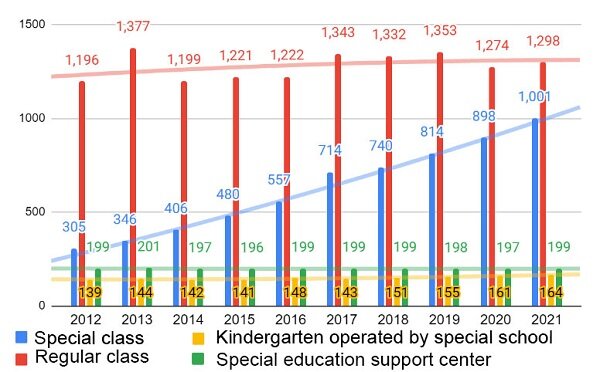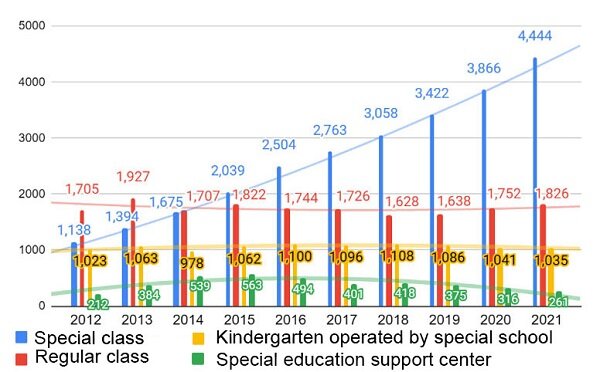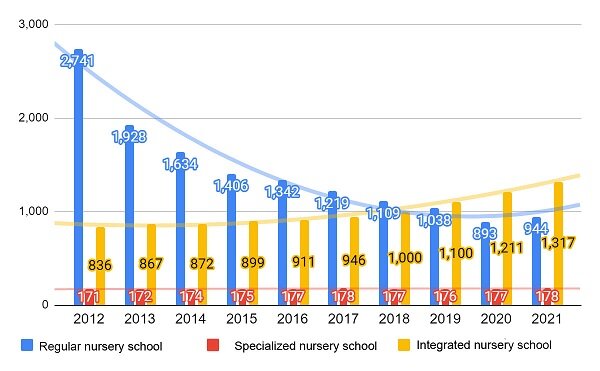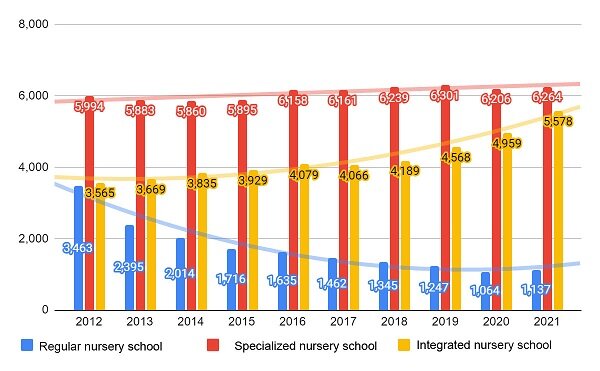Nowadays, accepting diversity is becoming increasingly important in all aspects of life. Under such circumstances, various policies have been implemented to ensure the welfare of people with disabilities. In particular, while the importance of educational systems where children with disabilities can equally receive education gains momentum, the concept of inclusive education covering all children with and without disabilities has become prevalent, not only at schools but also at kindergartens and nursery schools.
In South Korea, inclusive education has also garnered a great deal of attention. As a result, a lot of kindergartens and nursery schools have adopted inclusive education. In particular, nursery schools that accept at least three children with disabilities and satisfy statutory requirements are classified as "integrated nursery schools." The number of these integrated nursery schools is increasing every year. Therefore, in this report, I will discuss the structure and issues of inclusive education at preschools (including those accepting children with disabilities), considering the current conditions mentioned above.
1. Preschool facilities in South Korea
First, I will explain the system of preschool facilities for infants and young children in South Korea. Korean preschool facilities are roughly divided into two types: kindergartens and ŏrinijip (meaning "children's house" in the Korean language; hereinafter, "nursery schools").
Kindergartens are supervised by the Ministry of Education and accept preschool children aged from three to five years old. To become a kindergarten teacher, candidates need to be graduated from a vocational college or university majoring in "early childhood education" and have obtained a formal teaching certificate for kindergarten from the Ministry of Education.
In contrast, nursery schools are supervised by the Ministry of Health and Welfare and accept preschool children aged from zero to five years old. To be qualified as a nursery teacher, candidates need to have completed childcare courses, earned certain school credits at a vocational college or university, and obtained a formal certificate as a nursery teacher from the Ministry of Health and Welfare. In addition, persons who have graduated from high school but do not intend to proceed to university can still work at a nursery school after completing educational courses (qualified as a level-3 nursery teacher) at a teacher training school specified in the Ordinance of the Ministry of Health and Welfare.
Table 1: Differences between "kindergarten" and "ŏrinijip (nursery school)"| Kindergarten | ŏrinijip | |
|---|---|---|
| Competent authority | Ministry of Education | Ministry of Health and Welfare |
| Eligible children | Children from three to five years old | Children from zero to five years old |
| Teacher's qualification | Formal teaching certification for kindergartens | Formal teaching certification for nursery schools |
| Operating hours | Statutory operating days: minimum 180 days per year (determined by a director) | Open every day (except Sundays and national holidays) |
2. Preschool facilities for children with disabilities
The mode of preschool facilities that accept children with disabilities varies, depending on the competent authorities. For example, the Ministry of Education supervises (1) kindergartens, (2) kindergartens operated by special schools, and (3) special education support centers. These facilities, apart from kindergartens, accept only children with disabilities. In addition, some kindergartens have special classes where children with disabilities can participate in certain activities with typically developing children, thereby providing partially inclusive education. However, a considerable number of kindergartens do not offer such special classes and allow children with disabilities to attend a regular class, sometimes called an "integrated regular class." In such cases, all children will receive fully inclusive education and childcare.
Concurrently, preschool facilities accepting children with disabilities under the supervision of the Ministry of Health and Welfare include (1) regular nursery schools, (2) nursery schools specialized for children with disabilities ("specialized nursery schools"), and (3) integrated nursery schools for children with disabilities ("integrated nursery schools"). In particular, "specialized nursery schools" and "integrated nursery schools" are formally classified/specified as nursery schools providing special childcare for infants and young children with disabilities. More specifically, specialized nursery schools accept a minimum of 12 infants/children with disabilities and provide childcare focusing on medical treatments and support for these children. In addition, as specialized nursery schools provide inclusive education and childcare, they may also accept typically developing children up to 40 percent of their capacity.
Integrated nursery schools accept from three to twenty infants/children with disabilities. As can be inferred from their name, these nursery schools specifically provide integrated (= inclusive) education and childcare. They differ from kindergartens in that they do not have special classes in principle. Children with disabilities receive education and childcare together with typically developing children in the same class.
Finally, there are "regular nursery schools" accepting children with disabilities, which do not fall under either the category of "specialized nursery schools" or the category of "integrated nursery schools." Table 2 below summarizes the definition of each preschool facility according to the competent authorities.
Table 2: Preschool facilities accepting children with disabilities| Competent Authority | Facility type | Definition | |
|---|---|---|---|
| Ministry of Education (MOE) | Kindergarten operated by special school | A facility that installs special classes and provides special education for kindergarten courses. | |
| Special education support center | A facility that is responsible for the following: early detection, diagnosis, and assessment of children eligible for special education; information management; training for special education; support for teaching methodologies, learning activities, and other services related to special education; and the provision of itinerant education.i | ||
| Kindergarten | Special class | A class established in the regular school to conduct integrated education for children eligible for special education. | |
| Regular class | A class that does not fall under the category of "special class" and provides education for both typically developing children and children with disabilities. | ||
| Ministry of Health and Welfare (MHW) | Nursery school specialized for children with disabilities (specialized nursery school) | A facility designated by a local government, satisfying the requirements under Article 32 of the Public Welfare Act for Children with Disabilities and generally accepting a minimum of 12 children with disabilities. As it provides integrated education, it may also accept typically developing children up to 40% of its capacity. | |
| Integrated nursery school for children with disabilities (integrated nursery school) | A nursery school designated by a municipal government, allocating nursery teachers specialized in children with disabilities, installing/operating a regular class with children with disabilities (up to 20% of its capacity), and providing integrated education for a minimum of 3 preschool children with disabilities. | ||
| Regular nursery school | A nursery school that is not specified to provide special education, unlike integrated/specialized nursery schools. It provides education and childcare for typically developing children and children with disabilities in the same class. | ||
In addition, both the Ministry of Education and the Ministry of Health and Welfare publish reports on "Statistics of Special Needs Education" and "Statistics of Childcare Services," respectively. These reports include the statistical data of the facilities mentioned above. Therefore, I have created the following charts based on data extracted from these reports, published between 2012 and 2021. By use of these charts, I will discuss the current situation of inclusive education for preschool children with disabilities.
 Figure 1: Number of facilities accepting children with disabilities under the supervision of MOEii
Figure 1: Number of facilities accepting children with disabilities under the supervision of MOEii
Source: Authors' compilation based on data extracted from MOE's "Statistics of Special Needs Education"
 Figure 2: Number of children with disabilities attending facilities under the supervision of MOE
Figure 2: Number of children with disabilities attending facilities under the supervision of MOE
Source: Authors' compilation based on data extracted from MOE's "Statistics of Special Needs Education"
As I have mentioned, kindergartens are classified into two categories: "special class" and "regular class." The "Statistics of Special Needs Education" report provides the statistical data for these two categories.
(1) The above charts indicate that only the number of "special class" is continuously increasing among four types of facilities, and the number of children with disabilities attending special classes is rapidly increasing.
(2) In contrast, the number of "special education support centers" is decreasing, while the numbers of "regular classes" and "kindergartens operated by special schools" show marginal changes. This phenomenon is probably due to the "Five-Year Education Sector Development Plan for Special Needs Education." The government first developed the plan in 1998 to present basic educational policies for students needing special support education. The 6th five-year plan (2023-2027) is the latest version to be announced. In the past, the 4th five-year plan (2013-2017) produced a significant outcome: kindergartens' special classes have been newly established or added. The 6th five-year plan also plans the expansion of such special classes. It is important to provide more educational opportunities and options for children with disabilities. However, one concern may arise from this initiative, which is that children with disabilities will spend less time with typically developing children due to segregated education.
(3) In addition, parents of children with disabilities are more likely to choose fully inclusive education, in the hope that it will provide their child with more interaction among typically developing children. Therefore, besides increasing the number of special classes, it is also necessary to provide effective and practical support for the existing regular classes to ensure inclusive education.
 Figure 3: Number of nursery schools accepting children with disabilities
Figure 3: Number of nursery schools accepting children with disabilities
Source: Authors' compilation based on data extracted from MHW's "Statistics of Childcare Services"
 Figure 4: Number of children with disabilities attending nursery schools under the supervision of MHW
Figure 4: Number of children with disabilities attending nursery schools under the supervision of MHW
Source: Authors' compilation based on data extracted from MHW's "Statistics of Childcare Services"
The above charts indicate the following trends:
(1) Among the three types of facilities supervised by the Ministry of Health and Welfare, only the number of "integrated nursery schools" is constantly increasing. This trend proves that inclusive education is becoming extremely important in childcare settings.
(2) In contrast, the number of "regular nursery schools" has decreased by more than 50 percent over the past ten years. What does this trend indicate? Is the number of children with disabilities really decreasing? The reason is probably the impact of the free childcare program implemented by the government since 2012. The National Assembly for Integrated Nursery Schools hosted a national conference for social integration and integrated childcare for children with disabilities in 2015. At the conference, it was announced that since the implementation of free childcare program, children with disabilities who are not diagnosed can receive financial assistance for their childcare fees. As a result, there has been an increase in the number of undiagnosed infants/children with disabilities attending regular nursery schools.
(3) This means the number of children with disabilities is not decreasing, but the number of infants/children under the free childcare program is increasing without receiving financial support for children with disabilities.
This phenomenon points to a potential risk for children with disabilities. Due to the free childcare program, children with disabilities will miss out on opportunities to receive appropriate support. At the same time, this may impose a heavy burden on nursery teachers at regular schools. Therefore, the government should re-examine its educational support system to ensure support for children with disabilities not only at integrated nursery schools but also at regular nursery schools.
This article was prepared under the theme "Current Situation and Issues of Inclusive Education for Preschool Children in South Korea." I have discussed the current situation of inclusive education using ten-year statistical data on preschool facilities for children with disabilities published by the Ministry of Education and the Ministry of Health and Welfare. In the next article, I will explain the system and issues of teachers specializing in children with disabilities.
- (i) The term "itinerant education" means education provided for persons eligible for special education at school at each education level or in a medical institution, at home, or in welfare facilities, where special education teachers and persons in charge of special education-related services visit in person to educate them.
- (ii) Regarding special and regular classes, the figure represents the number of kindergartens establishing respective classes.
References:
- Ministry of Education, Science, and Technology. "2012 Statistics of Special Needs Education"
- Ministry of Education. "2013-2021 Statistics of Special Needs Education"
- Ministry of Education. "Act on Special Education for Persons with Disabilities"
- Ministry of Education. "Enforcement Ordinance for Act on Special Education for Persons with Disabilities"
- Ministry of Education. "6th Five-Year Education Sector Development Plan for Special Needs Education"
- Ministry of Education. "Early Childhood Education Act"
- Ministry of Health and Welfare. "2012-2021 Statistics of Childcare Services"
- Ministry of Health and Welfare. "Act on Welfare Support for Children with Disabilities"
- Ministry of Health and Welfare. "Enforcement Ordinance for the Act on Welfare Support for Children with Disabilities"
- Ministry of Health and Welfare. "Child Care Act"
- "The Age of Free Childcare: Integrated Childcare for Children with Disabilities Facing a Dilemma." Beminor. 2015-04-30. Beminor Digital. http://www.beminor.com/news/articleView.html?idxno=8284 (Last viewed on December 9, 2022).
Assistant Professor, Faculty of Education, Soka University.
Dr. An was born in South Korea and graduated from a Korean university, majoring in early childhood education. After obtaining her doctoral degree (pedagogy) from the Graduate School of Letters, Soka University, she has been engaged in research studies concerning children with disabilities and their families. Her main research topic includes “Interaction with children with/without disabilities and support for nursery teachers in inclusive education settings in South Korea.”
- [Japan] Identifying Factor Structures and Determinants Involved in the Development of "Non" Cognitive Skills in Early Childhood
- [South Korea] Current Situation and Issues of Inclusive Education for Preschool Children in South Korea - II
- A Useful Comparison Table for Improving the Quality of ECEC--International Comparative Study on Free Preschool Education and Childcare (74th OMEP World Assembly and Conference)














